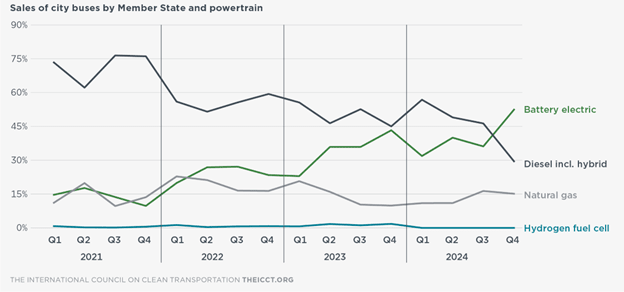As cities around the world move to reduce their carbon footprints and improve air quality, electrification of municipal fleets and public transportation has become a core strategy. In this week’s New Tech Tuesdays, we explore the exciting developments in this greener future, highlighting underlying technology from Phoenix Contact as well as the technical aspects and benefits for sustainable transportation.
Municipal Fleet Electrification
Municipalities are leading by example in the shift towards electric vehicles (EVs). They are replacing traditional service vehicles with electric models, significantly reducing emissions and operational costs.
- Service Vehicles: Garbage trucks and other public service vehicles are being replaced with electric models. This transition not only cuts down on greenhouse gas emissions, but also reduces noise pollution, creating a more pleasant urban environment.
- Electric Buses: Cities have begun replacing diesel buses with electric ones. According to the International Council on Clean Transportation, European Union sales of battery electric city buses eclipsed those of diesel-powered buses for the first time at the end of 2024 (Figure 1). This transition is beneficial in multiple ways. Electric buses produce zero tailpipe emissions, significantly reducing urban air pollution. Additionally, they have lower operating costs compared to diesel buses, making them a cost-effective solution overall.[3]

Figure 1: Sales of city buses in European Union Member States 2021–2024. (Source: “Race to Zero: European Heavy-Duty Vehicle Market Development Quarterly (January–December 2024)” by Eamonn Mulholland and Pierre-Louis Ragon, used under CC BY 4.0; Cropped from original)
Simplifying the Technical Jargon
Central to the electrification of municipal fleets is advanced charging technology. The growing adoption rates of electric vehicles for both consumers and municipalities owe much credit to the development of the Combined Charging System (CCS) standard. To help make these technical points more understandable, let us use a simple analogy. Think of CCS charging inlets as the high-speed internet of the EV world. Just as high-speed internet allows you to download movies in minutes instead of hours, CCS inlets enable electric vehicles to charge quickly, getting them back on the road faster.
The Newest Products for Your Newest Designs
As a critical part of the EV infrastructure, CCS vehicle charging inlets are designed to provide fast and efficient charging for electric vehicles, making them a cornerstone of the electrification movement.
Phoenix Contact CHARX CCS Vehicle Charging Inlets (Figure 2) are an optimal solution for fast and efficient EV charging. Designed to meet CCS Type 1 and Type 2 standards, these inlets ensure a seamless vehicle-side connection to chargers. They can handle up to 375A of continuous DC current, making them well-suited for fast-charging environments. With versatile built-in locking actuators—available in 12V or 24V options—these inlets cater to various needs.

Figure 2: Phoenix Contact CHARX CCS Vehicle Charging Inlets feature a 120mm² cable cross-section to ensure high current carrying capacity. (Source: Mouser Electronics)
With EV charging systems, robust insulation is crucial for long-term reliability, and these inlets feature an insulation resistance exceeding 200MΩ, which helps minimize leakage current and ensures compliance with industry standards. Highly accurate Pt1000 temperature sensors provide precise monitoring to prevent overheating. The robust design supports DC conductor cross-sections up to 120mm², enabling safe high-power charging (HPC) at 375kW, and over 500kW in boost mode. Rated IP6K7 and IP6K5, these inlets offer exceptional protection against dust, water, and dirt.
Ideal for electric vehicle manufacturers and special-use equipment builders, the Phoenix Contact CHARX CCS Vehicle Charging Inlets deliver reliable, high-performance charging infrastructure.







